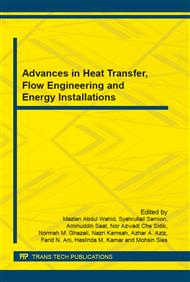[1]
D. Renné, Path to 100% renewable energy conference, in: SunBurst ed. Germany: ISES, (2013).
Google Scholar
[2]
J. Hawkins, Revolutionary time for the energy poor, in: Renewable Energy Focus, ed. USA: Elsevier Ltd, (2013).
Google Scholar
[3]
C. A. Chung, Simulation Modeling Handbook: A Practical Approach. USA: CRC Press LLC, (2004).
Google Scholar
[4]
S. J. Kowalski, Lecture Notes in Applied and Computational Mechanics vol. 8. Berlin: Springer, (2003).
Google Scholar
[5]
M. A. Gray, Introduction to the Simulation of Dynamics Using Simulink. USA: Taylor and Francis Group, LLC, (2011).
Google Scholar
[6]
R. J. Gran, Numerical Computing with Simulink vol. 1. USA: Society for Industrial and Applied Mathematics, Philadelphia, (2007).
Google Scholar
[7]
S. Kalogirou, Solar energy engineering processes and systems. USA: Academic Press, Elsevier Inc., (2009).
Google Scholar
[8]
R. M. da Silva and J. L. M. Fernandes, Hybrid photovoltaic/thermal (PV/T) solar systems simulation with Simulink/Matlab, J. Solar Energy, vol. 84, pp.1985-1996, 12/ (2010).
DOI: 10.1016/j.solener.2010.10.004
Google Scholar
[9]
G. N. Tiwari, Solar Energy; Fundamental, Design, Modelling and Applications: Alpha science International LTD., England, (2002).
Google Scholar
[10]
K. Sopian, M. A. Alghoul, E. M. Alfegi, M. Y. Sulaiman, and E. A. Musa, Evaluation of thermal efficiency of double-pass solar collector with porous–nonporous media, J. Renewable Energy, vol. 34, pp.640-645, (2009).
DOI: 10.1016/j.renene.2008.05.027
Google Scholar
[11]
K. Sopian, Supranto, W. R. W. Daud, M. Y. Othman, and B. Yatim, Thermal performance of double-pass solar collector with and without porous media, J. Renewable Energy, vol. 18, pp.557-564, (1999).
DOI: 10.1016/s0960-1481(99)00007-5
Google Scholar
[12]
B. M. Ramani, A. Gupta, and R. Kumar, Performance of a double pass solar air collector, J. Solar Energy, vol. 84, pp.1929-1937, (2010).
DOI: 10.1016/j.solener.2010.07.007
Google Scholar
[13]
J. A. Duffie and W. A. Beckman, Solar Engineering of Thermal Processes, 3rd ed.: John Wiley and Son Inc. USA, (2006).
Google Scholar
[14]
M. S. Buker, B. Mempouo, and S. B. Riffat, Performance evaluation and techno-economic analysis of a novel building integrated PV/T roof collector: An experimental validation, J. Energy and Buildings, vol. 76, pp.164-175, 6/ (2014).
DOI: 10.1016/j.enbuild.2014.02.078
Google Scholar
[15]
E. J. Finnemore and J. B. Franzini, Fluid Mechanics with Engineering Applications. USA: Mc Graw-Hill, (2002).
Google Scholar
[16]
A. Bejan, Convection Heat Transfer, 3rd ed. New Jersey: John Wiley and Sons, Inc., Hoboken, (2004).
Google Scholar
[17]
S. Pabis, D. S. Jayas, and S. Cenkowski, Grain Drying. New York: John Wiley and Sons, Inc., (1998).
Google Scholar
[18]
A. Bejan, Heat Transfer. New York: John Wiley and Sons, Inc., (1993).
Google Scholar


